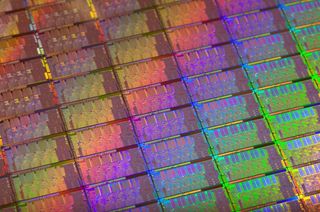Intel Ivy Bridge vs Sandy Bridge
What's staying the same and what's changing with the new processor?

It can be mighty confusing when chip giants release new hardware, under code names, relatively shortly after the part it's meant to replace, so here's a quick run down of what's new and what's not in Intel's newest CPU.
What stays the same?
Well, it's still the same style of CPU and GPU combo that made Intel's Sandy Bridge such an impressive wee beastie in the first place.
"Sandy Bridge was a pretty major platform repartitioning with a lot of things integrated on die. We retained a lot of the goodness that Sandy Bridge brought forward," said Varghese George, chief architect for Ivy Bridge, in today's tech insight into the new processor.
There will be a similar number of product offerings along the same line as Sandy Bridge in terms of SKUs, so we can expect the same sort of product line up in terms of i3, i5 and i7 variants including the K-series.
Ivy Bridge also retains the same Ring architecture that brings the CPU and GPU components together on die and unfortunately puts a limit on the overclocking side.
So it's still going to be a case of upping the multipliers and not the bus speed.
And only then if you've got one of the unlocked K-series chips in the first place.
Get daily insight, inspiration and deals in your inbox
Get the hottest deals available in your inbox plus news, reviews, opinion, analysis and more from the TechRadar team.
It has also retained the same socket configuration making it backward compatible with the previous generation.
Ideally that should mean any ol' Sandy Bridge mobo will be compatible with this new chip. That may not necessarily work in practice for all Intel 6-series motherboards, even with a firmware update, but that remains to be seen.
What gets changed?
Well, actually quite a lot. For a start the entire processor, GPU part too, will be manufactured on the 22nm production process. That means higher performance and lower power.
Combined with the lower power coming from the tighter lithography, thanks mostly to those much vaunted Tri-gate transistors, there's also a bunch of new power management goodies to go with it.
The main crux of this is the scalable feature set, including configurable Thermal Design Point (TDP) and Low Power Mode. These two are mainly to help OEMs design more scalable systems around the same architecture.
For example they will be able to set a system up using three separate TDPs; 'TDP Up', Nominal and 'TDP Down'. If the machine in question has a lower thermal envelope then using the chip in the lower power state will save on super-heated chips.
Interestingly Intel has also incorporated more overclocking goodness into Ivy Bridge.
You still have the locked multipler/K-series divide, but on the unlocked chips there is now increased maximum ratio support, moving the bar from x57 up to x63.
It has also introduced more dynamic overclocking, allowing the ratio to be changed on the fly without the need to reboot the machine.
This lends itself perfectly then to the application-based overclocking tools over the good ol' BIOS.
On the memory side too things have changed, with much more granularity involved in adjusting your DRAM's frequency. Where once you had to shift the speed of your memory in 266MHz increments you can now move in 200MHz jumps.
That small change could mean a lot in OC terms.
The big change for Ivy Bridge though is in the graphics core on board.
Where the CPU component follows perfectly on the tick tock Intel development model, with the simpler die-shrink tick following the more in-depth architectural revamp tock, the GPU part is being characterised as a 'tick plus'.
The new HD graphics in Ivy Bridge represents far more than just a die-shrink down to 22nm.
Because of the introduction of DirectX 11 support the whole GPU has effectively been redesigned. With the latest graphical API demands Intel has had to incorporate both Tessellation engines and Compute shaders into the mix.
With this redesign comes a far more modular GPU design, allowing the HD graphics of Ivy Bridge to be far more closely tailored to the individual SKUs. With Sandy Bridge desktop part you had two options, either the HD 2000 in the standard chips or the HD 3000 in the K-series alone.
That's changed now with Intel assuring us there will be lower power Ivy Bridge processors with the high-end Ivy Bridge graphics core on board.
So it will no longer purely be the domain of the top chips in the family.
On Sandy Bridge there was more of a disconnect with only the top-end K-series chips have the top-end graphics. Yes, those CPUs that were more than likely going to be paired with a discrete card anyway.
The Ivy Bridge GPU also comes with its own L3 cache too. This means the graphics side of the processor no longer have to keep calling on the shared cache of the CPU side.
But it's not just in the technicalities that things have changed on the graphics side, performance is apparently well up.
"Don't be surprised if the performance is significantly higher," said Intel Senior Fellow and grumpy graphics guru, Tom Piazza.
Piazza wasn't able to talk numbers unfortunately with the chip still six months or so away, but he did say that both the QuickSync video and 3D gaming performance where very much on the rise.
So things are looking impressive for Intel's next, next chip. After all, we've got the seriously high-performance Sandy Bridge Extreme parts coming in a month or two to whet our appetite.
Most Popular


